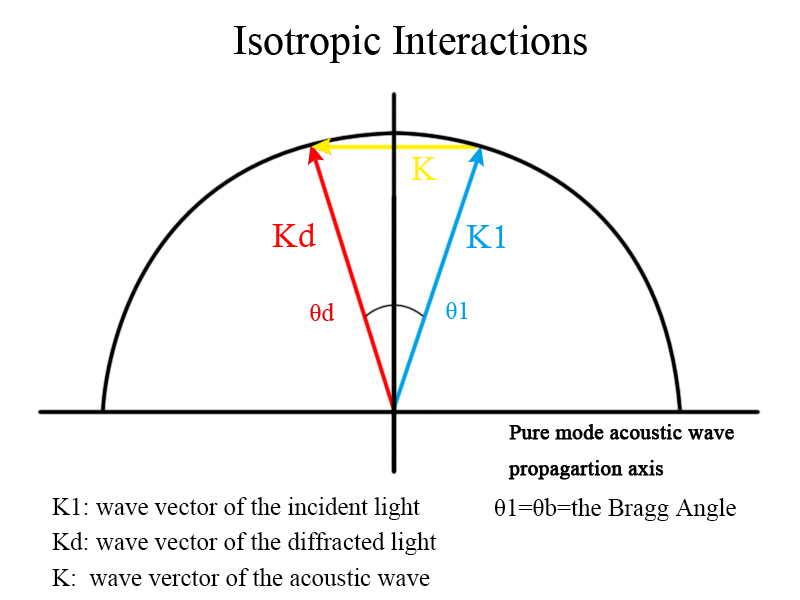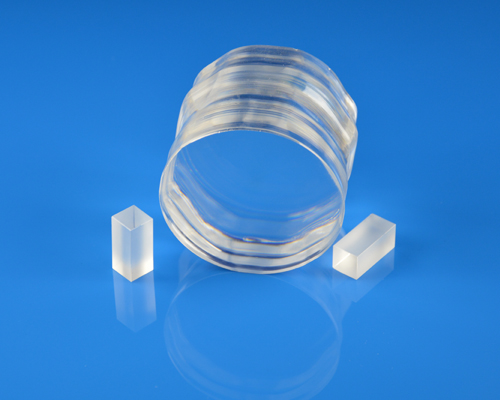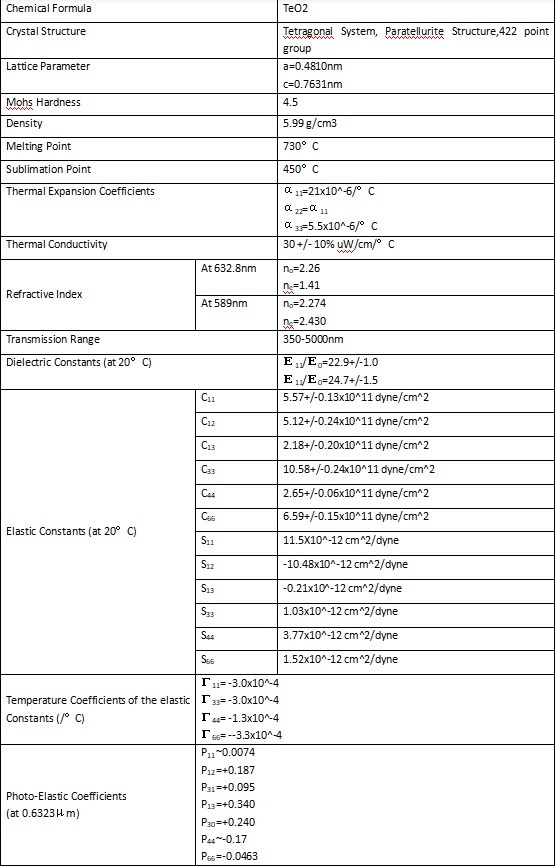Introduction to Acousto-Optic Crystals
What are Acousto-Optic Crystals and Acousto-Optic Modulators:
Acousto-Optic Crystals are crystals that exhibit photoelastic effects, where mechanical waves stimulate elastic strains in the crystals, acting as periodic phase gratings and altering the refractive indices, leading to changes in the optical properties. One simple explanation of the fundamental working scheme is that when the mechanical oscillation field compresses the crystal material, the refractive index will subsequently increase, when the mechanical waves stretch the crystal, the result will be just the opposite.
Acousto-Optic Crystals are extensively utilized in Acousto-Optic Modulators(AOM), which modulates the laser beams through the interaction of light waves and the acoustic waves or put it more tangibly, light diffraction induced by the AO crystal media. The most conventional configuration of an AOM includes a crystal material, polished to optical-grade, through which the light is modulated, an RF driver that generates electrical signals to the attached to a piezoelectric transducer, the piezoelectric transducer that transforms the oscillating electrical fields to acoustic waves, and an acoustic wave absorber at the end of the AO crystal media to ensure unhindered light propagation by preventing the formation of stationary waves (or a resonant device for operation mode utilizing stationary waves). The whole set is usually installed in a box, with two optical windows at the sides to allow light passage. Hangzhou Shalom EO provides high-quality AR-coated optical windows compliant with the application of AOMs.
Diffraction Regimes:
There are normally two kinds of diffraction regimes, the Raman-Nath-Regime, where one incident light beam is diffracted into several orders, and the Bragg-Regime, where one light beam is refracted into only one order.
Raman-Nath-Regime:
This takes place when the wavelength of the acoustic waves is relatively long and the incident angle is perpendicular to the propagation direction of the acoustic waves. Because the wavenumber of the light wave is significantly greater than the acoustic wave, the gratings could almost be regarded as stationary, and the light waves barely interact with the mechanical wave. In this situation, the emerging light wavefront will be in the shape of a bumping sinuous curve, which describes light diffraction of multiple orders.
Bragg Regime:
The Bragg Regime only takes place when mechanical wavelengths are relatively shorter than in the case of the Raman-Nath-Regime, and when light is incident upon the acoustic wavefronts at a certain angle called the Bragg Angle. In this situation, both the amplitude and phase of the light wave are modulated, and multiple orders of diffracted light interfere with each other, leaving only 0 order diffraction and 1 or -1 order diffraction. Numerically, the Bragg Angle could be formulated as:
θ=λfa/Va=2θb
Where θb is the Bragg Angle, λ is the optical wavelength, fa is the freq. of the acoustic wave, and Va is the velocity at which the acoustic wave propagates in the material. From the equation, you might easily notice that the Bragg Angle is related to the wavelength of the acoustic wave, which means though controlling the RF freq. one could control the angle of diffraction. This is the basic principle of the Acousto-Optic Deflectors.
Bragg regime is much more common than the Raman-Nath regime in applications of AOM since its modulation bandwidth is much wider and its diffraction efficiency is much higher than the latter.
Important Factors of Acousto-Optic Crystals
Transmission range:
The crystal should be highly transparent at the light wavelength of interest to minimize the power loss of the system.
Figure of Merit:
For most applications, a high Diffraction Efficiency would be beneficial. Studies show that with crystals of a higher figure of merit it is easier to attain excellent diffraction efficiency. For instance, the numerical formula of diffraction efficiency for Bragg Regime is:

η is the diffraction efficiency, L and H are the lengths and the height of the cross-section of the transducer, M is the figure of merit of the material, and P is the power supply required. From the equation, it is evident that with a limited power supply (which is often the case in real applications), a higher figure of merit will proportionally elevate η.
Large Size Capability:
Large mode areas are necessary in some cases which challenges the accessibility of large-size crystals. For example, for high-power applications, a large aperture size increases the damage threshold. And for acousto-optic deflectors of high resolution,a greater aperture size is also vital. One alternative approach is to focus the light beam using optical lenses, the potential risk of this is the loss of the optical power diffracted. Furthermore, with greater aperture size, the rise time might also be limited, since the rise and fall time of an AOM for beam shuttering is defined as the transit time of the acoustic wave through the light beam, which equals to:
Rise Time = Diameter of the light beam/1.5xthe velocity of the acoustic waves
Polarization dependant or not:
For isotropic crystal materials, the output polarization will remain the same as the input polarization. For anisotropic materials, the polarization state of the input light will be altered, which means anisotropic materials could only function normally at a certain polarization direction. In the case of isotropic materials, the interaction is highly symmetric, the incident light and the diffracted light encounter the same refractive index, while in the case of anisotropic materials the refractive index changes corresponding to changes in the polarization state.
The diagrams below depict the isotropic interactions and anisotropic interactions, where for the former the wave vectors of the incident and the diffracted light are approximately equal, and for the latter, the two vectors differ. Additionally, for anisotropic interactions in the slow shear mode, under some particular circumstances, the diffraction vector only changes mildly corresponding to a significant change in the acoustic wave vector. This fact suggests that it is possible to realize broadband modulation using anisotropic materials.

Figure 1. Shows the Isotropic Interactions.

Figure 2. Shows the Anisotropic Interactions. The outer hemispheres represent the Index Ellipsoid of a biaxial crystal.
Different Types of Acousto-Optic Crystals:
Prismatic AO Crystals:
For these crystals generally, a relatively mature growth technology has been developed, hence it is easier to obtain single crystals of larger sizes. The elastic-optical coefficients of the crystals are not significant, and their figures of merit are also low, but with them low acoustic loss is possible, allowing the manufacturing of broadband acousto-optic devices. Such crystals are prone to form color centers under X-ray or ultraviolet light irradiation, so they are not suitable for applications in short-wavelength bands. The most representative examples are Yttrium Aluminum Garnet (YAG) crystal, BSO, and BGO crystal.
Uniaxial AO Crystals:
These AO crystals are the type with relatively high reliability in the visible spectrum. The major kinds include LiNbO3, LiTaO3, and Quartz crystals of trigonal crystal system, Lead Molybdate (PbMoO4), Tellurium Dioxide (TeO2) and Mercury Bichloride (HgCl2) of tetragonal crystal system, and Sapphire of hexagonal crystal system. Growth of these crystals is not difficult, what troubles the industry is the large size capability. Among them, Lead Molybdate and Tellurium Dioxide (TeO2) are prominent due to their high figures of merit attributed to large elastic-optic coefficients and high refractive indices. The PM and TeO2 are the most prevalent Acouto-Optic Crystals.
Biaxial AO Crystals:
These AO crystals feature low symmetry and thus strong anisotropy. This implies greater freedom for optimization of the Acousto-Optic Modulators but also brings inconveniences to the design and application. In addition, low symmetry makes crystal growth more difficult. One newly developed kind is Lead bromide (PbBr2) crystal, which performs great at visible to mid-infrared wavelengths. It has a high figure of merit and good crystal quality.
Semi-Conductor AO Crystals:
The transmission wavelength range of these crystals penetrates into the infrared spectrum, and the crystals are therefore apposite for IR applications. The crystals have decent refractive indices and large elastic-optic coefficients. However, due to the large acoustic loss of the semiconductor materials, the application bandwidth is limited. Cubic Tellurium (Te) crystals and Monocrystalline Germanium (Ge) are popular infrared acousto-optic Crystals.
Applications of AOMs:
Q-Switch:
The switching is realized by turning the acoustic field “on” and “off”. When no acoustic wave is applied, the laser beam passes through the device unaffected. When an acoustic wave is applied, the refractive index of the AO media changes periodically, the laser beam is subsequently deflected, leading to a lower Q value, hence oscillation is prevented, and meanwhile accumulates the population of particles in the upper energy level. In the context of Acousto-Optics, a Q-switch refers to the component that generates usually 10kW pulse power from CW Nd: YAG Lasers. The performance of the AOM used as a Q-switch is determined by the contrast ratio:
Cavity Dumper:
In the context of Acousto-Optics, Cavity Dumper refers to the component that operates inside the cavity of Ar ion Lasers to generate short-pulsed light.
Mode Locker:
Acousto-optical mode-locking is a measure of active mode-locking, which uses the Acousto-Optic Mode Locker to perform periodic loss modulation on the laser oscillation in the resonator so that each longitudinal mode has a certain phase and the amplitudes are coupled to each other to form a mode-locked pulse output.
For some application fields, such as pumping OPCPA, pump source for high-energy all-solid-state pulsed lasers, and research on ultrafast processes of certain materials, acousto-optic mode-locked high-stability light sources with pulse widths of hundreds of picoseconds are the ideal light source.
Acousto-Optic Tunable Filters (AOTF) and Polychromatic Acousto-Optic Modulators (PCAOM):
Because the Bragg Angle varies with the change in wavelength, an AOM could be utilized to select light of certain wavelengths from a light source of a significant spectrum. Such a component is called an AOTF or a PCAOM. TeO2 operating in the shear mode is an excellent crystal material for manufacturing AOTF. The large figure of merit of Tellurium Dioxide reduces the obligatory power supply to the RF driver, with the design of a compensation prism to reduce the separation angle. In the laser show industry, AOTF and PCAOM could be applied as a color mixer to individually modulate laser lines and further blend the colors.
Acousto-Optic Deflectors (AOD):
An Acousto-Optic Deflector is a component for precise spatial control of the output light, or continuous/random light scanning within a certain angle. In fact, an AOM and an AOD are intrinsically the same. If one only alters the power output of the RF driver, while maintaining the wavelength of the mechanical wave, so that the position of the diffracted light beams remain the same but their intensity is modulated, in this situation the component is called an AOM. In contrast, if one only alters the wavelength of the mechanical wave, so that the intensity of the output light is not affected but causes changes to the directions of the diffracted light, in this situation the component is called an AOD. Therefore, an acousto-optic modulator could equally function as an ancousto-optic modulator simply by altering the way one manipulates the RF driver.
For the acousto-optic deflectors, the main concerns include resolution(both static and dynamic), access time, etc. Materials with a large refractive index and slow mechanical wave propagation velocity are generally more advantageous. Common materials incorporated in the AODs are PbMoO4, TeO2, Dense Flint glass, etc. PbMoO4 and TeO2 feature a high figure of merit, and feasibility for short wavelength. Dense Flint glass is cheaper than crystals and much easier to acquire ingots of large size, however, due to great loss of transmission at short wavelengths, it is mainly selected for long-wavelength applications.
Acousto-Optic Frequency Shifter (AOFS):
When a laser beam propagates through the phase gratings created in the acousto-optic media of an Acousto-Optic Frequency Shifter (AOFS), it experiences the Doppler Effect, where the frequency of the mechanical wave superposes with the frequency of the light wave. Since normally the actual application of the components requires minimum power loss, therefore AOFS is usually operated under the Bragg-Regime.
For a first-order Bragg diffraction (i.e. when the propagation directions of the light and the acoustic wave are the same), the eventual freq. of the output light is the sum of its original freq. AND the RF freq. . For a minus one order Bragg diffraction, the result is just the contrary.
TeO2 is an ideal crystal material for AOFS. The input light is shifted through anisotropic interaction of slow shear modes in TeO2, then the unshifted input beam is orthogonally polarized to the diffracted, shifted beam. A polarizer could then be applied externally to the AOFS to achieve a high extinction ratio between the diffracted and undiffracted beams.
Tellurium Dioxide (TeO2) and its applications in the field of Acousto-Optics:
Tellurium Dioxide, chemical formula TeO2 belongs to the tetragonal crystal system with one optical axis, is considered the best Acousto-Optic Crystal due to its high figure of merit, excellent transmission at the 514nm, 633nm, 1064nm and 1330nm wavelengths.
In the Acousto-Optic Industry, TeO2 is especially favored in the production of Acousto-Optic Deflectors (AOD), Acousto-Optic Tunable Filters (AOTF), Acousto-Optic Frequency Shifters (AOFS), and Acousto-Optic Modulators (AOM).
Tellurium Dioxide crystal is a colorless, transparent crystal with versatility in the Acousto-Optic and Piezo-Electric realms. The family of TeO2 crystals could be classified into three structure kinds, currently only Gamma TeO2 of the Paratellurite structure could be artificially grown. The grown TeO2 crystal exhibits prevailing optical, acoustic, and piezoelectrical properties including slow acoustic wave phase velocity in the [110] orientation, minor acoustic attenuation, high figure of merits, large refractive index, and great transmission to the visible light. What especially attractive about it in the Acousto-Optic field are its low acoustic propagation speed and high refractive index.

Figure 3. TeO2 Crystal Ingots and Laser-grade Components offered by Shalom EO.
Structure:
The structure of Gamma TeO2 is Paratellurite, pertaining to the 422 point group and D4,4-P41212 space group. The pattern of the Te and O atoms observed from the projected diagram in the [001] plane is octahedral molecular geometry, with the Te-O4 group forming a trigonal pyramidal construction, and two additional next-nearest O atoms, so that in total there are six O atoms surrounding one Te atom in each functional group. And it is equally important that functional groups of the octahedral geometry are connected to each other at their apex points, and are respectively titled. The degree to which the groups are tilted depends on the temperature and tends to approach the ideal rutile structure as temperature rises. This trait contributes to the fact that for TeO2 crystals its elastic properties exhibit extraordinary temperature responsiveness in certain circumstances.
Operation Modes:
There are mainly three operation modes of the Acousto-Optic Modulators developed on the basis of TeO2 crystals: The first is the slow shear mode propagating in the [110] direction and making displacements in the [110] direction, the advantage of using this mode is low acoustic attenuation, and tremendous figure of merit relative to this orientation (M2=n^6P^2/ρv^3=793x10^-18 S^3/g). The second, longitudinal wave in the [001] orientation, referring to the modulation bandwidth, the figure of merit is relatively high (M1=n^7P^2/ρv=142x10^-7cm^2·S/g). The third is where the shear wave propagates in the [001] plane, with an angle of 35.9° to the x-axis, and making displacements in the [001 ]direction. The character of this mode is zero temperature sensitivity and a rather high figure of merit (M=200x10^-18 S^3/g). It is also worth noting that acoustic attenuation of sound waves traveling in the [110] direction is comparatively higher than the sound waves traveling in the [001] direction.
Properties of TeO2 Crystals:

Acoustic Velocities of TeO2 Crystals for Various Operation Modes measured at 20℃:

Acousto-Optic Properties of TeO2 Crystals:

The Relationship between the Propagation of the Acoustic Wave and the Acoustic Attenuation:

Applications:
TeO2 Acousto-Optic Deflectors:
TeO2 crystal is the most prevalent material for AODs, featuring a quite decent large size capability and exceptional figure of merit which contribute to a high resolution.
Main Characteristics of TeO2 Deflectors (Note that the values stated below should not be interpreted as absolute values. The values are only selected as the most representative under general conditions.) | |
Transmission Wavelength Range of Light | 514nm, 633nm, 1064nm,1330nm or even broadband applications (e.g. 440-532nm, 750-1064nm, 1065-1100nm, etc) |
Aperture | 1-15mm |
Operation Mode | Slow Shear Mode, or Shear, Off Axis |
Deflection Angle | 30-60mrad |
Separation Angle | 60-80mrad @80MHz |
Diffraction Efficiency | 70-85% |
Power for RF Driver | 1-5 watts |
Access Time | 1.5us |
TeO2 Acousto-Optic Tunable Filters:
Main Characteristics of TeO2 Tunable Filters (Note that the values stated below should not be interpreted as absolute values. The values are only selected as the most representative under general conditions.) | |
Transmission Wavelength Range of Light | 514nm, 633nm, 1064nm,1330nm, Band Width 3-15nm |
Aperture | 1-20mm |
Operation Mode | Slow Shear, Off Axis |
Freq. | 17-200MHz |
Diffraction Efficiency | 90-95% |
Field of View | +/- 1-3° |
TeO2 Acousto-Optic Modulators:
Main Characteristics of TeO2 Modulators (Note that the values stated below should not be interpreted as absolute values. The values are only selected as the most representative under general conditions.) | |
Transmission Wavelength Range of Light | 514nm, 633nm, 1064nm,1330nm |
Aperture | 0.3mm-3mm |
Operation Mode | Longitudinal, axis(001) |
Hangzhou Shalom EO offers TeO2 crystals of superior quality at competitive prices. A complete production chain for the growth, cutting, and processing of the crystals is developed in Shalom EO, with rigorous quality inspections done before delivery. Shalom EO's tellurium dioxide crystals are particularly suitable for manufacturing Acousto-Optic Modulators, Acousto-Optic Deflectors, and Acousto-Optic Tunable Filters for applications from the visible to the IR wavelength range (optical transmission band from 350-5000nm), and featuring an impressively high figure of merit, low acoustic attenuation, etc. The crystals could be offered in the form of boules and ingots, crystal blanks, or laser grade polished and coated.
Related Articles
Related Products
Tags: Introduction to Acousto-Optic Crystals


